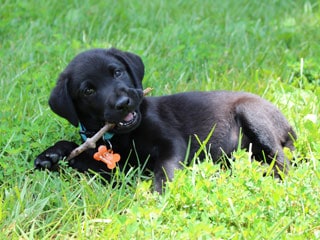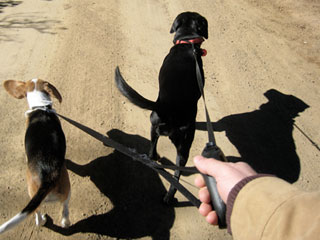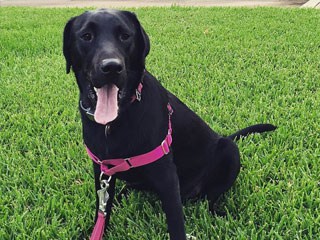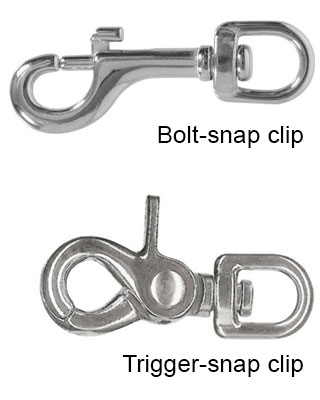You come home at the end of the day tired and all you want to do is sit on the couch and put your feet up. Meanwhile, your dog is running all around you full of energy. You know you should take him for a walk but do you really need to? Yes, of course, you do!
Your dog has been sitting home all day. He is most likely bored and needs some activity. A nice brisk walk is exactly what he needs. Plus it will be good for you too.
How Much Should You Walk Your Dog?
The amount of walking your dog needs varies depending upon his age, health, and size. In general, your dog loves to go for walks. He enjoys being outdoors and meeting new people.
Puppies under 3 months of age don’t need specific walks. In fact, you need to be careful not to let them play too hard as they will over-exert themselves.

After the puppy has reached 3 months, the five-minute rule is a good way to determine how much walking he should do. Allow 5 minutes of structured walking and/or play time for each month of his age. So, for example, if the puppy is 3 months old he should have approximately 15 minutes of structured activity daily.
Once your dog reaches one year of age, you should be walking him about 2 miles every day. This can be divided between 2 walks in a day if you prefer. Try to keep a fairly quick pace as regular walking is not too much of a workout for your most dogs. In fact, keep in mind that your dog will probably need other exercises as well. Walking is great but we rarely actually keep a pace that gives our dog much of a workout. Fetching, swimming, and running are also great ways to exercise your dog.
If your dog is older or has health problems, you will need to adjust his walks accordingly. Don’t overexert your dog. Keep his pace steady and his exercise gentle. If he seems tired or in discomfort, then it is time to take him home.
Best Time of Day to Walk Your Dog
Labradors have a double coat which means they can heat up fairly quickly. If you own a Lab, it is best to walk him in the cooler parts of the day, especially during those hot, summer months.
During the warmer months, walking your dog first thing in the morning will help to prevent him from becoming overheated. Labradors tend to be excitable and energetic when they wake up so you might as well put his excitement to good use. Similarly, dusk is another good time to walk your dog, as the day is beginning to cool down. Taking him out at this time has the additional benefit of burning off energy before bedtime.
During the colder months, mid-day works well as it is usually the warmest part of the day. If it is cold outside, watch your dog carefully. If he is shivering then it may be too cold for him.
Whenever you’re taking him for a walk, make sure he has plenty of water available when you return home so that he won’t get dehydrated.
How to Stop Your Dog from Pulling
 Sometimes when you walk your dog you wonder who is walking whom. Does he pull so far ahead that you feel like you’re the one on the leash? This is a habit that needs to be trained out of your dog.
Sometimes when you walk your dog you wonder who is walking whom. Does he pull so far ahead that you feel like you’re the one on the leash? This is a habit that needs to be trained out of your dog.
Most Labradors need lots of exercise. Remember, he has probably been sitting around the house all day. When you get him outside he will be is ready to run. Keeping a fast pace as you run will not only help to prevent him from pulling but will also help him to expend his pent-up energy.
Another way to help minimize pulling is to exercise your dog before you go for a walk. Try playing fetch or running around the house or yard. In this way, way once you begin your walk, he will have already burned off much of his excess energy and be ready to walk along with you at a more moderate pace.
When you are walking your dog if he starts pulling on the leash stop walking. Wait until he comes back to you or allows some give to the leash. Reward him when he walks beside you instead of in front of you. This will reinforce a normal pace and will discourage him from racing ahead of you.
Choosing the Best Harness and Leash for Your Dog
The Harness
Labradors are big, strong dogs with lots of energy so you need to be able to keep good control of them while out on your walks. A harness gives you more control than a collar and won’t pull tight across your dog’s neck. Choosing the proper harness will help you do this.

One of the best choices for a many dogs is the front-clip harness. The front-clip style of harness is especially helpful in preventing pulling issues as well. When your dog pulls, this harness tightens slightly against his chest and shoulders. This helps to redirect his energy and pull him back towards you and gives you more control over as you correct him.
There can be issues with any harness, so make sure to find one that fits your dog properly. Measure his chest and look for one with the proper thickness and padding. Make sure the harness doesn’t irritate his skin or leave raw spots. A good rule of thumb is that you should be able to easily slip two fingers between the harness and your dog. Watch for sagging chest straps or slippage of the harness. These two things can indicate the wrong size harness or could indicate that the harness is of poor quality.
Choosing a Leash
There is a glut of leashes available to the conscientious pet owner, so how do you choose the best one for your dog? The primary things to consider are leash quality and your dog’s habits.
Today’s modern leashes can be made out of a variety of materials, including nylon, leather, rope, and chain. Although chains are less common, they are beneficial for dogs who like to chew on their leashes. While the chain-style leashes can’t be chewed, they are heavier than the nylon or leather variety, and can sometimes rust.
Nylon
Nylon leashes are durable, strong, and come in a wide variety of different lengths, thicknesses, and colors. They also tend to be more affordable than other styles of leashes. When nylon gets wet it doesn’t shrink and is usually easy to clean. Some issues with nylon leashes include that they can be chewed through and can also cause friction burns, especially if your dog takes off and causes the leash to whip through your hands. Overall, nylon can be an excellent choice if you pick the right one. Make sure it’s strong and thick. You want a leash that is durable and long-lasting.
Leather
Another good choice for a leash is leather. This option can be more expensive but these leashes often last longer than any other style. Leather is durable, long-lasting, and more difficult for your dog to chew through than nylon. Over time, leather softens and changes its shape, which can make it a more comfortable leash for your dog. Of course, it can still be chewed through and can also cause friction burns.

Whichever leash you choose make sure it is thick and has a good sturdy clip on it. Make sure the clip is made of either stainless steel or brass which will prevent rust. A bolt-snap clip is an acceptable choice. This style of clip is strong, usually reliable, and is easy and quick to use. Just keep in mind that the spring-loaded snap tends to weaken over time, making it easier for your dog to pull the leash off the snap.
To avoid this situation, the trigger-snap clip may be a better choice. Trigger-snap clips have an overlapping snapping mechanism operated by a thumb-trigger that will not allow the dog’s harness or collar to be pulled out of the clip. When your dog pulls, the Trigger-snap clip is held close through mechanical force, instead of allowing itself to be pried open like a bolt-snap clip.
Standard vs. Retractable Leashes
A standard leash is usually a better choice than a retractable one. The retractable leashes can cause friction burns. They also may encourage your dog to pull on his leash, as they give him more slack to run forward. A standard 6-foot leash is the best to use.
When choosing your leash, leather and nylon are both great options. Just make sure to find a good quality leash that will last.
What to Do When Encountering Other Dogs
While you are out for a walk with your dog, it is common to come across others doing the same. What is the best way to handle this situation?
The first thing to keep in mind is that your reaction is most important. If you tense up or tighten the grip on his leash then he will think there is something to be afraid of. This can cause him to act aggressively. Don’t be hesitant or fearful.
Watch the other dog. Does he seem aggressive? Is he on a leash? Use this information to help decide your course of action.
If you think the encounter may go poorly, try to change your route. If this isn’t possible, keep space between the dogs and try to keep from having them approach each other face to face. If they feel crowded or challenged this can cause a bad reaction.
Use small treats or attention diverters like sounds or commands to keep your dog distracted. Reprimand him when needed and praise him when he handles an encounter well.
The most important thing is for you act confident and speak calmly. Your dog will follow your lead.
Final Thoughts
Most dogs love being outside. Labradors are playful, energetic dogs who needs to be active and stimulated on a daily basis. He loves the fresh air and meeting new people. Walking helps to keep his heart and muscles strong. It also helps to keep his mind stimulated and his weight under control. Keep in mind he will probably need more exercise than just his walks, but those daily excursions will return so many benefits for him and you.
Did you find this article helpful?
Click on one of the Share Links below to share it with a friend.

